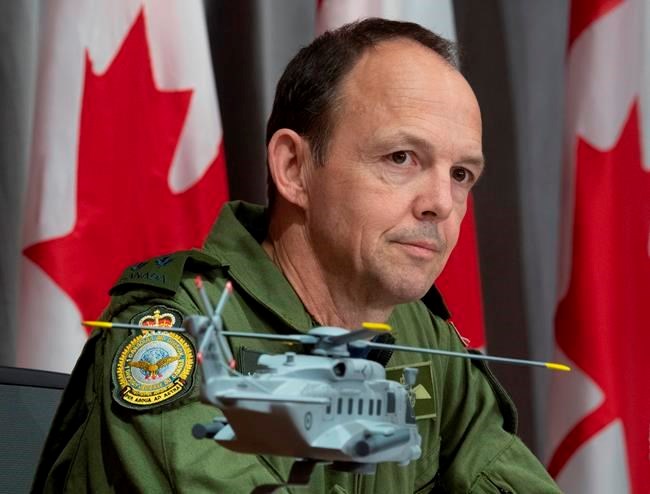OTTAWA — Senior military officials have revealed there was a "conflict" or "competition" between a Cyclone helicopter and its pilot moments before the aircraft known as Stalker 22 plunged into the water off the coast of Greece in April.
Lt.-Gen. Alain Pelletier, commander of 1 Canadian Air Division, suggested Tuesday the problem was the result of a "series of events" and only occurred within a "very narrow band" of flight activities that had not been previously identified or tested.
The revelation came as the Royal Canadian Air Force announced it was lifting an "operational pause" imposed on the rest of the military's Cyclone fleet after the crash, even though the reasons for that conflict remain under investigation.
The entire fleet was temporarily grounded after Stalker 22 crashed into the Ionian Sea on April 29 while preparing to land on the Halifax-class frigate HMCS Fredericton following a NATO training mission and photo-op.
The military said last week, in a brief report on the probe's preliminary findings, that the helicopter did not respond to something the way the crew expected.
In announcing the resumption of flights, Air Force officials said investigators have been able to recreate the circumstances surrounding the crash using information from the Cyclone's flight-data recorders, which were recovered from the sea.
The problem occurred as the helicopter was coming around to land on the Fredericton, officials said. The pilot attempted to make a number of manoeuvres while the Cyclone's "flight director," or autopilot, was still engaged.
Rather than turning off, the autopilot started to work against the human pilot before the helicopter crashed into the water at high speed. All six Armed Forces members on board were killed, the largest single-day loss of life for the military in more than a decade.
The Cyclone's computer ended up "in competition with the inputs that the pilot was trying to actually induce in order to set the recovery," Pelletier said during a news conference. "That element of conflict resulted because of the flight-control inputs."
"The crew would have had no previous experience nor exposure prior to this event on how to handle the situation," added Col. John Alexander, the Air Force's head of flight safety and lead investigator.
"The accident was unavoidable based on their low altitude and, consequently, the lack of time they had to realize that the aircraft was not responding to their inputs."
Even as the officers said they are now examining why the helicopter responded how it did, they expressed confidence in the Cyclone and announced plans for the rest of the helicopter fleet to resume operations in the next few days.
The resumption will be accompanied by new training and updates to flight manuals so pilots know about the problem and how to respond if it arises, as well as restrictions on certain flight activities.
The crash of Stalker 22 was the third-known — and deadliest — incident involving a Cyclone not responding as expected since the helicopters first started being delivered to the military in 2015 after more than a decade of developmental issues.
A software problem in the flight control system of one Cyclone in March 2017 caused the helicopter to suddenly drop during a test flight. Another had a "hard landing" on board the navy’s interim support ship while deployed in the Pacific in February 2019.
Officials insisted Tuesday that the problem that caused Stalker 22 to crash was different and that the Cyclones, some of which have yet to be delivered by Sikorsky Aircraft, were put through proper testing before being deployed on real missions.
"We assured the helicopter underwent a thorough certification process before confirming it met the requirements of the technical airworthiness program and being approved," said Brig.-Gen. Nancy Tremblay, head of aerospace equipment program management.
They also refused to point fingers at who was responsible for the problem, saying an assessment would be needed to determine why the Cyclones' autopilot responds the way it does in certain circumstances.
This report by The Canadian Press was first published June 16, 2020.
Lee Berthiaume, The Canadian Press



